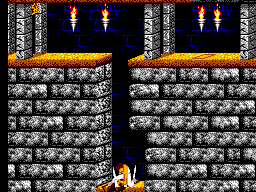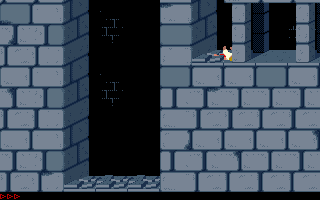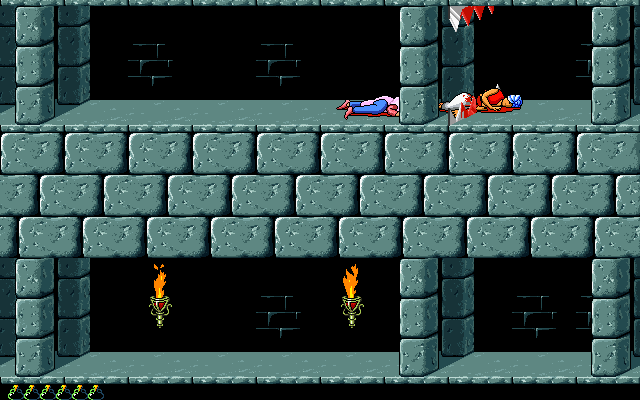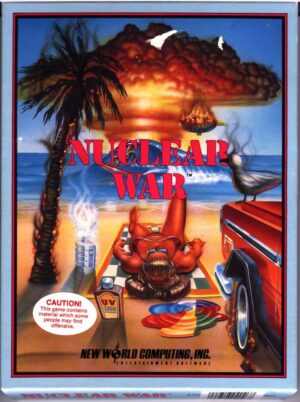Retro Replay Review
Gameplay
The core of Prince of Persia’s gameplay revolves around precision and timing. Players control the protagonist through a labyrinth of corridors, pits, and trap-laden chambers as they attempt to reach the princess within a strict one-hour countdown. Unlike typical run-and-jump platformers of its era, this title demands careful observation of the environment—watching for pressure plates, rotating blades, and collapsing floors before making each move. The sense of vulnerability is palpable, as a single misstep often means instant death and a restart from the beginning of the level.
(HEY YOU!! We hope you enjoy! We try not to run ads. So basically, this is a very expensive hobby running this site. Please consider joining us for updates, forums, and more. Network w/ us to make some cash or friends while retro gaming, and you can win some free retro games for posting. Okay, carry on 👍)
Puzzle elements are woven seamlessly into the platforming action. You’ll need to step on pressure pads to raise portcullises, drag levers to open secret passages, and occasionally backtrack to trigger mechanisms. These environmental puzzles are never overly complex, but they break the monotony of pure platforming and keep you engaged. Timing is everything: linger too long considering your next move, and the countdown clock may slip past the crucial one-hour mark.
Combat is skeletal yet satisfying. Encounters with palace guards are resolved through basic swordplay, where well-timed parries and strikes decide victory. You begin with three health points, recoverable through small health potions found in urns, and can expand your endurance by locating larger jars. Though the fight sequences are brief, they punctuate the tense exploration with bursts of action, forcing you to balance caution with aggression.
Graphics
One of Prince of Persia’s most celebrated achievements is its use of rotoscoping for character animation. The smooth, lifelike movement of the prince brings an unprecedented cinematic quality to a 2D platformer. Whether vaulting across a gap or recovering from a near-fatal fall, each motion feels natural, enhancing the sense of immersion in the palace’s deadly corridors.
The level design is deceptively simple yet rich in atmosphere. Walls, floors, and ceilings share a consistent sandstone palette, evoking the Sultan’s opulent palace, while subtle decorative details—like flickering torches or intricate mosaics—imbue the environment with authenticity. Traps such as swinging blades, spiked pits, and hidden dart launchers stand out in silhouette, providing clear visual cues without sacrificing mystery.
Although Prince of Persia was originally an Apple II game, ports to the SNES, Genesis, and Game Boy Color added new levels, refreshed graphics, and altered color schemes to suit each platform’s strengths. Despite minor variations, the overall aesthetic remains cohesive, and the fluid animations transcend hardware limitations, ensuring a consistent visual experience across consoles.
Story
The narrative thrust of Prince of Persia is simple yet effective: while the Sultan is away at war, his Grand Vizier Jaffar seizes power and kidnaps the princess, forcing her into an unwanted marriage. Thrust into a dungeon, the nameless hero has only one hour to escape, vanquish the guards, and overthrow Jaffar’s usurpation. This ticking-clock premise injects urgency into every moment, turning exploration into a race against time.
Though the storyline unfolds in just a few text screens, it provides enough context to drive the player forward. The trope of “rescue the princess” may feel familiar, but the one-hour time limit elevates the drama by making failure a visceral experience: death isn’t just a lost life, but a reminder that the princess’s doom inches closer with every misstep.
Characterization is minimal by design. The prince remains silent and nameless, allowing players to project themselves into his plight. Jaffar’s tyranny and the princess’s innocence need no elaborate backstory; the straightforward good-versus-evil conflict creates a clear motivation. In the end, it’s the gameplay tension rather than a complex plot that makes the story memorable.
Overall Experience
Prince of Persia stands out as a seminal work in the cinematic platformer genre, marrying fluid animation with tight level design and a relentless time constraint. The blend of platforming, puzzle-solving, and brief combat sequences keeps the experience varied, while the rotoscoped movements deliver a level of realism rarely seen in its contemporaries.
Replay value remains high thanks to the challenge of shaving seconds off your best time and discovering all health-upgrading jars hidden within the palace. Each failed run is a lesson learned in path optimization and trap anticipation. While modern gamers accustomed to checkpoints and save-anywhere systems may find the hour-long run daunting, the original design’s difficulty is a key part of its enduring appeal.
For newcomers, Prince of Persia offers a compact yet intense adventure that laid the groundwork for countless successors. For retro enthusiasts, it’s a nostalgic journey back to an era when every jump and swing of the sword carried the weight of genuine risk. Either way, the game remains a classic testament to how innovative design and technical artistry can create an unforgettable gaming experience.
 Retro Replay Retro Replay gaming reviews, news, emulation, geek stuff and more!
Retro Replay Retro Replay gaming reviews, news, emulation, geek stuff and more!









Reviews
There are no reviews yet.